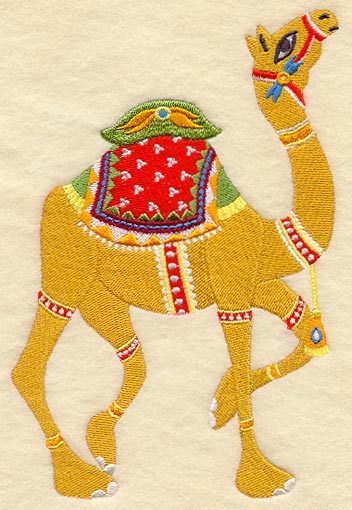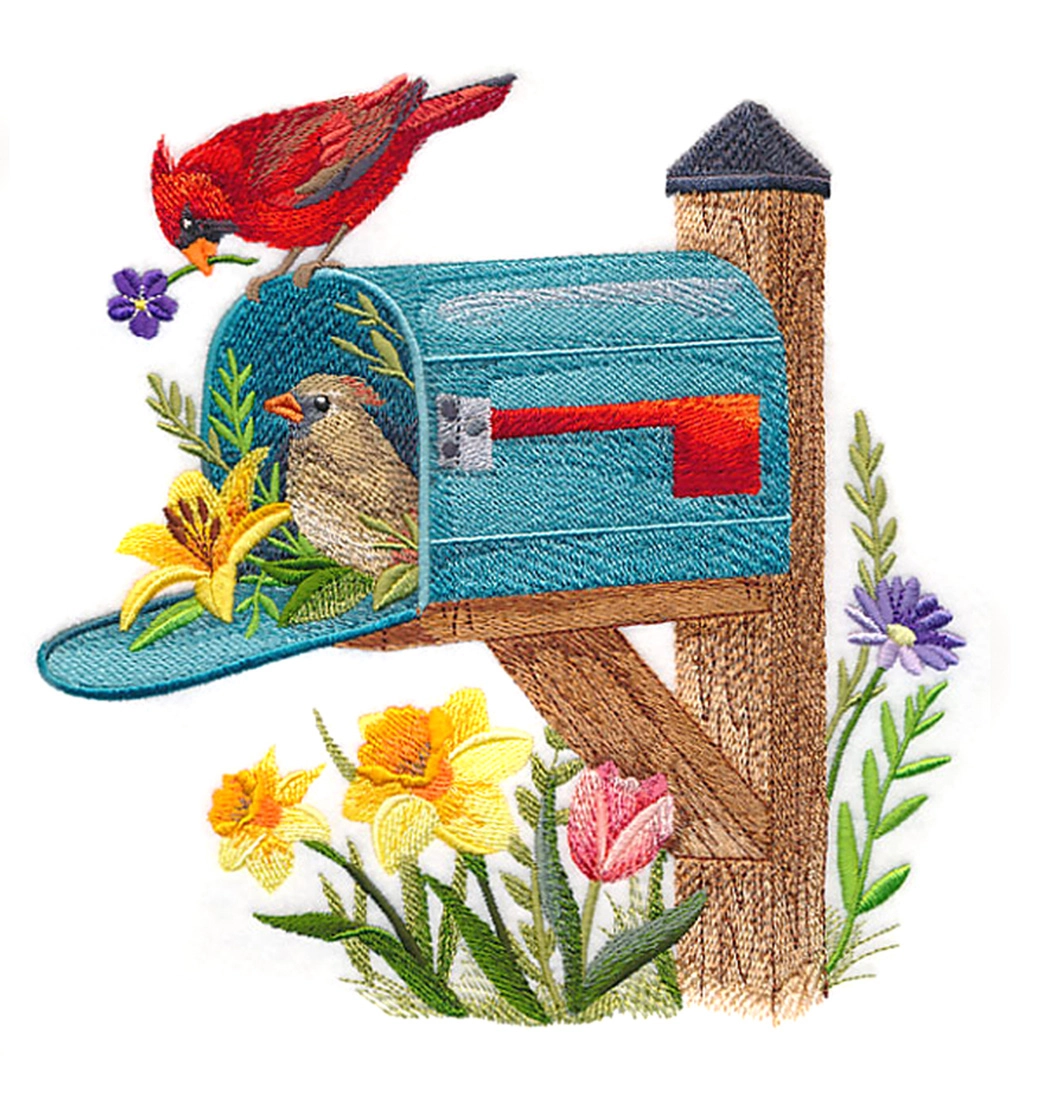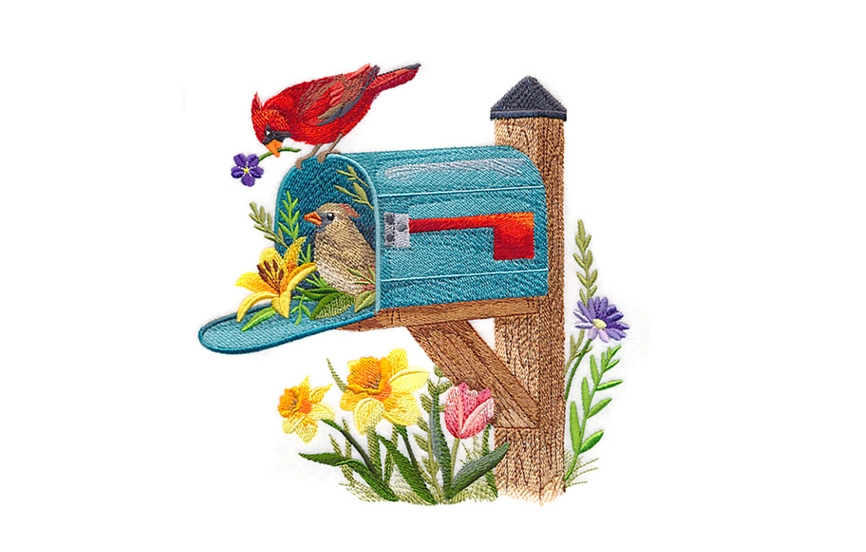Designs Used
It's soft....slippery....shiny....and strong, too. Silk is the strongest of all natural fibers. It's breathable, warm in the winter, cool in the summer, and naturally hypoallergenic. Garments made with silk maintain their form and graceful drape for their entire lifetime.
For fabric-aholics, silk is the Holy Grail. We stop at yard sales to dig through boxes of abandoned fabric, hoping that maybe -- just maybe -- there's a treasure to be found.
And yet when we find that treasure, we hesitate. While the fibers in silk are strong, the fabric is surprisingly delicate. Impurities in the air can weaken the fibers, as can sunlight and moisture. Do we really want the silk? It's difficult to clean, nearly impossible to launder, so once we have that perfect silk shirt or suit, we never, ever wear it.
There's one word to describe silk: fickle. Some days it's our best friend, and the slippery and luxurious feeling makes us feel as rich as kings and queens. Other days the hefty price tag and cautioning care instructions makes us feel like paupers. See what I mean? Fickle. But then, that's what we can expect from a fabric that has the most exciting history of fabrics.
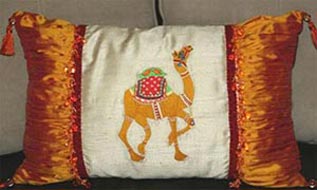
According to Chinese mythology, in the 28th century BCE a 14-year-old empress named Leizu found a silkworm cocoon in her tea cup. While removing it from her drink, she noticed that the cocoon began to unravel in long threads.
Leizu had an idea to weave it, and told her husband, the Yellow Emperor. The emperor gave his wife a grove of Mulberry trees, and Leizu began the practice of sericulture, the art of raising silkworms and creating silk.
Thirteen hundred years later, silk production in China was a prosperous industry. Silk was used for everything from musical instruments to paper to currency for domestic and foreign trade. And, for thirteen hundred years, silk production was the best-kept secret on the planet. Only China knew how to do it.
As people began to migrate from China to other parts of Asia, their knowledge of silk production went with them. In some cases, the secret of silk was transported away from China in very creative ways. One princess hid silk and a silkworm in her hair when she was married to a prince in Khotan. In another early form of industrial espionage, two monks visited Asia on a religious mission, and returned to Byzantium with silkworm eggs hidden in their wooden walking sticks!
Throughout the following centuries, silk production spread from continent to continent through explorations, crusades, wars, and takeovers. And, by the 18th century CE, Europe, Japan and Africa were also involved in the silk industry. Eventually, through exceptional planning and organization, China regained their historic first place ranking as the world's largest producer and exporter of silk. They still maintain that top position today.
What was this amazing technique that the Chinese so voraciously guarded for so many years? It is a tedious and lengthy process that starts with the hatching of silkworms. Two conditions are then necessary to ensure the highest quality of silk: the moth must be prevented from hatching out of its cocoon, and the silkworm's diet. Baby silk worms eat and eat (and eat!) mulberry leaves until they become almost 10,000 times their weight. They then enter their cocoon stage for eight to nine days in which they are dropped in hot water to eradicate the worm. The cocoons become loose and the filaments, which are 600 to 900 meters long, are then wound onto a spool. Five to eight filaments are twisted together to create thread, which is finally ready for weaving into cloth.
Silk's quality is not measured in thread counts such as cotton fabrics, but by the momme weight system. It is comprised of a different set of standards than in other fabric industries. To determine the momme weight of silk (mm), the equation is the weight of 100 yards by 45 inches of silk, in pounds. Five momme (mm) is very light and transparent, while 22 mm is much thicker and heavier. Higher momme weights indicate that more silk is used in the weaving process. Within a one meter width of silk, 1600 to 1800 threads are considered to be poor quality; 2000 threads are said to be of good quality.
Silk fabric is can be found worldwide in many items. Garments and apparel, like blouses, sarees, skirts and suits, are the most common use of the fabric, although in more recent times, it has made its way into home decor. Sheets, throws, pillows, and drapery will add an incredibly elegant touch to any room. One lesser known use for silk is in the medical field where antibacterial, medicated silk fabrics have been developed to keep healing skin free from cuts, burns, and bedsores.
One a recent trip to JoAnn fabrics, I found only a few types of silk fabrics in the fashion and home decor sections. While there many types of silk (chiffon, brocade, damask, and tussah) the three types of silk I found locally were charmeuse, dupioni, and shantung.
I found the lightweight charmeuse material with the fashion fabrics. When we think of traditional silk, this is the type we envision. With its luminous shine, silky feel and beautiful draping, charmuese is commonly used for scarves, blouses, and lingerie.
Dupioni silk was also present with the fashion fabrics. A plain-weave, stiff taffeta-like fabric, dupioni is known for having uneven and irregular threads called 'slubs.' It ranges in weight from light to medium weight, and works nicely for evening gowns, semi-fitted vests, and fine suits. Dupioni isn't recommended for garments that are too fitted because it doesn't stand up well to stress.
Shantung is a medium to heavy silk that is often a combination of rough silk and heavier dupioni yarns. While often used in making garments, I found it in the home decor department. That's because this type of fabric is becoming more common in drapery, swags, and table runners. The plain weave, also with slubs, is semi-crisp and can have a lustrous or dulled finish. Even though shantung silk is heavy, it drapes quite nicely without being cumbersome. The same precautions for fitted garments apply to shantung as dupioni.
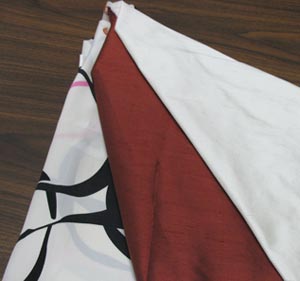
Here's a photo of the three types of fabric. From left to right, they are charmeuse, shantung, and dupioni.
Because all three have a delicate weave, I did all of my testing with a 75/11 sharp needle. I thought that a needle with a rounded tip (embroidery, ballpoint, stretch) would tear the delicate fabric and leave visible perforations.
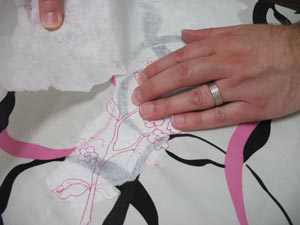
This chameuse silk, full of lively and modern pink and black swirls, is very light-weight and a bit translucent. Such a silk calls for a very light design such as toile or redwork. I chose to embroider the very light Cherry Blossoms design from the Japanese Quick-stitch (Bluework) Pack -- but instead of using blue thread, I choose a pink that coordinates with the fabric.
Because the designs were light, and because cutaway stabilizer would show behind the translucent fabric, I used tear-away stabilizer. I didn't use any spray adhesive, which would likely damage the silk with its moisture.
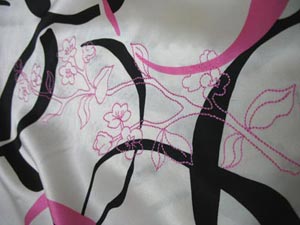
When removing the tear-away stabilizer, use one hand to hold down the outer edges of the design, while gently using the other hand to tear away the excess stabilizer.
The bottom picture shows the finished result, which is crisp, clean, and has no stabilizer showing through.
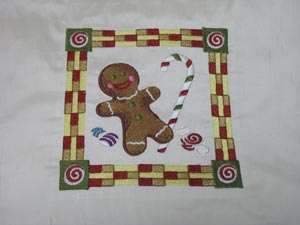
Textured, sturdy dupioni silk can support heavier, solid-filled designs, but it is necessary to take draping into consideration. Using a light to medium design will allow for the fabric to hang nicely. I embroidered one of the Sweet Christmas Squares designs onto this ivory dupioni using a medium weight (2 oz.) cutaway stabilizer, lightly sprayed with a temporary adhesive. Make sure to tightly hoop the fabric and stabilizer together.
Once again, the design looks cleanly stitched and the silk drapes nicely.

The deep red shantung or decorator silk that I found is of a medium-to-heavy weight, and has a crispness to it. It has similar weights and textures to dupioni silk (and because it contains dupioni yarns).
This sturdy silk is able to handle medium-to-complex designs. As an example, I chose to embroider the medium-sized, solid-fill Autumn Splendor Panel - Elm Tree design.
Once again I used a medium weight cutaway stabilizer. I lightly sprayed it with temporary adhesive and smoothed the shantung silk over the stabilizer before tightly hooping them together.
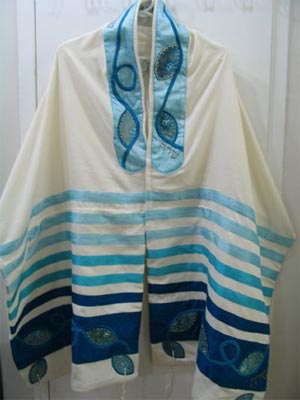
Several beautiful projects using silk have been submitted to the Stitchers Showcase:
Marilyn's beautiful, silk prayer shawl was created to be worn during Jewish services and holidays.
Her combination of dupioni silk, lace, and applique makes for a wonderfully elegant and garment.

Regina embellished vibrant silk purses that she purchased from Gecko Traders in Arlington, Virginia with the Standard Poodle designs. She used her Bernina 180 machine.
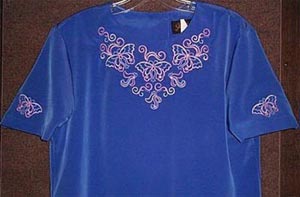
Sherry, from Ohio, made a plain silk top into a silky, shiny gem of a shirt. She embroidered the blue silk shirt with designs from the Butterfly's Flight Sweater Set along the neckline, and added some extra sparkle with crystals. Sherry sews on a Toyota 860.
When caring for silk, always first check the manufacturer's label. Although silk can withstand heat, extreme temperature changes in the home washing cycle or overheating through excessive drying will damage the fabric.
Some silk can be hand-washed, but it must be done carefully. Use a mild detergent like Woolite with lukewarm water. Roll, don't twist, the fabric in a towel to absorb the excess water. You can machine dry the garment, but make sure to remove it while it is still damp and hang it on a hanger to complete drying.
Overall, dry-cleaning is your best option, especially if the silk is particularly delicate, structured, multi-colored, or hand-dyed. If you are unsure or have any doubts, always choose dry-cleaning over hand washing.
Silk tends to shine when ironed, but this can be avoided by using a steam iron on a low setting, with a press cloth. Silk will yellow and fade with too much heat.
Be aware that moths will not only attack wool garments, but silk ones as well. Use a breathable cover, such as a cotton pillowcase, when storing silk clothing. Plastic storage can trap moisture and lead to yellowing and mildew.
Stitching tips for silk:
